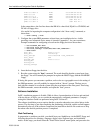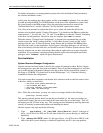
Linux Installation and Configuration Guide for AlphaServer 25
ECG513/0100
Password: user@
ftp> bin
ftp> cd /pub/DEC/Linux-Alpha/Images/
ftp> get generic-smp-2.2.12.img
ftp> quit
2. Insert a blank, formatted floppy into the computer, and copy the BOOT kernel to it:
$ dd if=generic-smp-2.2.12.img of=/dev/fd0
With this floppy in hand, you are now prepared to begin the installation process on your
AlphaServer or AlphaStation.
Firmware Inspection and Upgrade
After powering up your AlphaServer or AlphaStation computer, type the command "show
version". Check that the version string printed is "V5.4-2 May 19 1999 14:25:16" or newer, and
that the first letter of the version string is a "V". If this is not the case, you should upgrade your
firmware. Instructions on how to do this can be found at
http://ftp.digital.com/pub/Digital/Alpha/firmware/ along with the latest firmware images.
System Resource Manager Configuration
There are several pieces of information that you need to configure in the SRM subsystem, as well
as device identifiers that you should make note of, prior to beginning the installation process. The
steps that follow take you through that process.
1. Power up your system. After several diagnostics are completed, you will be presented an
SRM prompt "P00>>>", as shown here:
1024 Meg of system memory
probing hose 1, PCI
bus 0, slot 7 -- ewa -- DE500-AA Network Controller
bus 0, slot 8 -- pka -- QLogic ISP1020
probing hose 0, PCI
probing PCI-to-ISA bridge, bus 1
bus 0, slot 5, function 1 -- dqa -- Cypress 82C693 IDE
bus 0, slot 5, function 2 -- dqb -- Cypress 82C693 IDE
bus 0, slot 8 -- pkb -- QLogic ISP1020
bus 0, slot 9 -- vga -- ELSA GLoria Synergy
System Temperature is 24 degrees C
initializing GCT/FRU at offset 1d0000
AlphaServer DS 20 Console V5.4-2, May 19 1999 14:25:16
P00>>>
2. Determine what devices your system has installed. In particular you will need to note your
installation device (a floppy and/or CD-ROM), and your target disk drive. Entering the
command "show devices" as shown below will print out the information about your system:
P00>>>show device
dka0.0.0.8.1 DKA0 RZ1DF-CB 0371
dkb500.5.0.8.0 DKB500 RRD46 1337
dva0.0.0.0.0 DVA0
ewa0.0.0.7.1 EWA0 00-00-F8-10-AE-C5
pka0.7.0.8.1 PKA0 SCSI Bus ID 7 5.57
pkb0.7.0.8.0 PKB0 SCSI Bus ID 7 5.57
In the output above, the first line shows that DKA0 is a hard disk, DKB500 is a CD-ROM,
and DVA0 is a floppy drive.


















